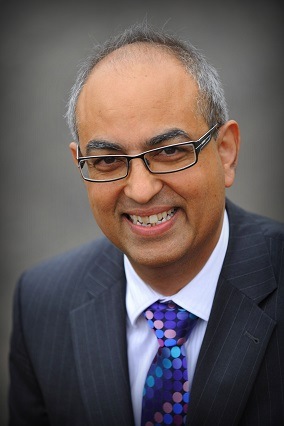
“Patient safety must come first, alongside the recognition of the essential role interventional radiology plays in the provision of modern medical care,” Raman Uberoi, consultant interventional radiologist and honorary senior lecturer, John Radcliffe Hospital, Oxford, UK, and current president of the British Society of Interventional Radiology (BSIR) tells Interventional News. Uberoi also outlines some of the challenges of providing a 24/7 interventional radiology service in the UK and calls for major investment in interventional radiology nationally to train and appoint more consultants and allied health staff.
What is current situation with 24/7 provision of interventional radiology services?
Every acute trust has a duty to ensure that there are formal arrangements to secure provision of elective and emergency interventional radiology services. Several surveys have shown that this is not occurring. In the most recent survey, around 2/3 hospitals had some form of cover either internally or networked for nephrostomy and endovascular interventions; just over half had cover for haemorrhage control; and less than half had cover arrangements for post-partum haemorrhage. This, of course, means there is huge post code lottery with some centres having excellent provision, while others have none, or minimal, cover arrangement.
What medical conditions does the 24/7 provision currently cover?
The major indications for treatment with interventional radiology is haemorrhage control ie trauma bleeding, gastrointestinal haemorrhage, post-partum haemorrhage, aortic dissections and ruptures (both thoracic and aortic) using stent grafts, sepsis control (ie nephrostomy, biliary drainage and abscess drainages), acute peripheral and visceral ischaemia due to arterial occlusions that require thrombolysis. Bowel obstruction is another area where interventional radiologists can improve patients’ overall condition using urgent colonic stenting prior to definitive surgery. Acute stroke treatment is another focus area where there is a desperate need for a national strategy with the development of acute thrombectomy centres. Interventional radiologists will be key members of the team potentially delivering this service (See Trevor Cleveland’s article on page 41.)
What are the goals of the BSIR in this regard?
We aim to put patient safety first, recognising the essential role of interventional radiology in the provision of modern medical care. We are working on recognising the resources and manpower required to provide a 24/7 interventional radiology service. It is of extreme importance to be clear and transparent regarding the local provision of interventional radiology services and decide what is, and what is not possible to provide, in and out of hours.
We aim to enter into discussions with healthcare authorities and other trusts in the region to make arrangements which ensure robust and coherent regional interventional radiology service provision 24 hours a day, seven days a week.
We would want there to be either a local on-call or networked on-call solution with a minimum of six consultant interventional radiologists on a 24/7 call rota with similar rotas for our allied health staff, ie, nurses and radiographers to provide safe and sustainable 24/7 emergency care.
What are some of the challenges with regard to providing 24/7 services?
The key factors in this regard are adequate infrastructure and support. There is a significant shortage of staff to run this service, particularly of consultants. As things stand, we are short of around 220 interventional radiology consultants, and see similar shortages of nursing and radiography staff. How can they be met? There needs to be a recognition that in the absence of provision of interventional radiology services, patients will be placed at risk. There needs to be an immediate-, medium- and long-term strategy to deal with this staffing shortfall. In all healthcare trusts, there should be an exploration of ways in which a comprehensive service may be offered by internal reorganisation, maintenance of core skills, additional funding/training/appointments, or external networking.
There should be clarity within the trust and among referring clinicians and service commissioners about what interventional radiology services are available and when they are available. If a service is not available at all, within or outside routine working hours, for example, embolization for acute haemorrhage, this should be known to the clinical governance authorities. Where there is an unmet clinical need, it is the responsibility of the clinical and medical director to have made all reasonable attempts to ensure these interventional radiology services are available to all patients 24/7 and discussions should take place about purchasing appropriate services from another trust. It should be clear which particular interventional radiology services are being purchased.
Clear pathways should also be in place for treating patients appropriately when the interventional radiology service is not available. The trust’s clinical governance process and relevant referring clinicians need to be aware of the situation. This will allow discussion about planned patient pathways when the service is not available, for example, default to surgical treatment, and also document an area of possible need for service development. When a service is not provided on a 24-hour basis, and if this usually results in patients being transferred to other trusts, this pattern of referral requires clarification with the clinical governance processes and agreement on the part of the receiving trust. There should be formal contractual arrangements for patient transfer, including appropriate clear protocols for patient transfer in a timely fashion, lines of clinical responsibility, patient repatriation and funding.
In the medium to long term there is a need for major investment in interventional radiology nationally to train and appoint more consultants and allied health staff.
There needs to be a significant increase in training numbers to increase interventional radiology consultants for the future. We need to ensure that there are good training opportunities for clinical interventional radiologists. Vascular procedures form the bedrock of training for all the key areas of emergency and urgent interventional radiology and training centres need to have access to a range of vascular and nonvascular procedures to learn the core skills that are required to carry out these important procedures.
What do you aim to achieve in your presidential term?
I want to ensure that we are training sufficient numbers of clinically focussed interventional radiologists. We need to increase training opportunities and the numbers of trainees to meet the current and future challenges of providing a high quality, safe and sustainable 24/7 interventional radiology service. This means not just having a strategy to increase training numbers, but having an appropriate curriculum which focusses on training clinicians who can assess and manage patients as well as have the knowledge and skills necessary to carry out complex procedures. I want to ensure that interventional radiologist have sufficient clinical time to provide a high quality, safe and sustainable service, which requires time for clinics, ward rounds, patient follow-up, audit, and research to demonstrate the huge benefit of interventional radiology.
I want to ensure that the value of having a good interventional radiology service is clearly recognised, both clinically and financially. This can only be achieved by having good effectiveness data and a sound financial platform for trusts to support our services with appropriate interventional radiology tariffs that cover the range of procedures we undertake.










